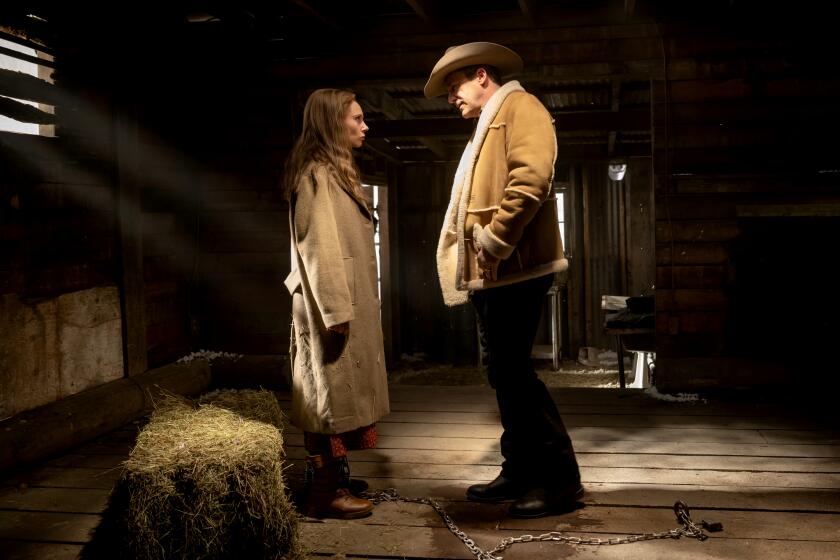50 years later, Martha Mitchell finds redemption in ‘Gaslit’

Ever since his arrival in Hollywood in 2006, Robbie Pickering, creator of the Starz limited series “Gaslit,” about the downfall of the Nixon White House, had been trying to sell a series about the Watergate scandal. “I’d given up hope,” says Pickering, who traces his obsession with the unraveling of the Nixon administration to 1994 when he watched his mother sob during the televised funeral of the only United States president to resign from office.
It wasn’t an official pitch to a disinterested executive, however, that eventually turned his series into a reality. It was, to his great surprise, a workplace chat during his time as a staff writer on USA Network’s “Mr. Robot.” Pickering casually suggested to his boss, “Robot” creator Sam Esmail, that he listen to the first season of Leon Neyfakh’s podcast “Slow Burn,” which memorably recounted all that transpired after the bungled break-in at the Democratic National Committee headquarters in 1972. The following day, Pickering got a call from his agents: Esmail had optioned the rights to “Slow Burn” with the idea that Pickering come on as showrunner and adapt it for the small screen and that Esmail would serve as executive producer.
“My dream of making a Nixon show happened without me even having to pitch it,” Pickering says, still sounding a bit amazed. “I hadn’t even developed a story or how I was going to approach it.”
One of the things that surprised and captivated Esmail and Pickering, both self-proclaimed Nixon completists, was the revelation in the opening “Slow Burn” episode that Martha Mitchell, wife of Nixon Atty. Gen. John Mitchell, and a flamboyant socialite from Arkansas with a taste for strong cocktails and wee-hour phone calls to reporters, had actually played a central role in the unraveling of the Nixon administration.
“It’s been 50 years. How has this person not been explored?” Esmail asks. “Lots of other people got credit for breaking the Watergate scandal open, most of them men. The fact that Martha, who was such an integral player in all of this, was silenced by her husband, the media, the press and obviously, people in power? To me, it was so relevant to what we’re experiencing today.”
“Martha was always [portrayed as] a tangential character. Everybody dismissed her, even the good historians,” Pickering adds. “She was a hero, a complex one, but a hero.”
Before Pickering was finished writing the pilot, though, Esmail was already in touch with Julia Roberts, whom he’d worked with and befriended on Prime Video’s “Homecoming,” another podcast adaptation, and had come to envision as the perfect Martha Mitchell. Though Roberts notes she didn’t know much about the woman nicknamed “the mouth of the South,” she trusted Esmail’s instincts. “He just gets me, and I get him,” she says. “We’re together now forever. He cannot shake me.”
Once onboard, Roberts began a deep Martha dive, reading everything she could find and studying footage from past interviews. Eventually, she chose to reverse-engineer her character. “I’d seen the interview that she did late in all this with Barbara Walters when she’s pretty obviously intoxicated on morning television. Not just on television. On morning television. So to me, working backwards, I was like, ‘OK, how does somebody end up there? How do you end up sitting with Barbara Walters on the ‘Today’ show at 8 o’clock in the morning s—-faced?’ And that’s where I started.”
In mapping out the course of “Gaslit,” Pickering drew inspiration from HBO’s “Enlightened,” Mike White’s series featuring a flawed female protagonist who is neither villain nor savior. He also looked to Mike Nichols’ 1966 film “Who’s Afraid of Virginia Woolf?” and a 1964 British drama, “The Pumpkin Eater,” because he wanted to structure “Gaslit” around two marriages caught in the swirling upheaval of Watergate: the Mitchells, whose loving relationship was destroyed by it, leading to divorce in 1973, and the union between Maureen (Betty Gilpin) and White House counsel John Dean (Dan Stevens). Dean eventually testified about the cover-up before Congress, and the ordeal ultimately strengthened their bond.
“This series gives a window into what it was like to be thrown into the public eye just because you’re in love with someone who happens to be committing crimes and misdemeanors on the side,” Gilpin says. Regarded back in the ‘70s as a frosty stoic with white-blond hair, Mo Dean in Gilpin’s performance is smart and opinionated, a stabilizing force for her ambition-driven husband’s plight. “She’d been married twice before, and she wasn’t going to let love go. I think that really helped John see what the right thing to do was,” Gilpin says.
When it came to the visuals, Pickering knew he wanted “Gaslit” to feel modern. “We didn’t want to just make a ‘70s throwback TV show,” he says, “like, we’re just using wigs or costumes or production design as a crutch.” That said, makeup artist Kazu Hiro managed to blindside Esmail with his makeover of Sean Penn into the graying, double-chinned John Mitchell. “I walked on set and I said hi to Julia and a couple of actors,” says Esmail. “Then I saw someone in the back, kind of lingering and waiting for me to say something. Finally, I realized it was Sean. It wasn’t just the prosthetics. There was a subtleness in the mannerisms and the way he taught himself to move. I was just taken aback.”
The transformation that meant the most to Pickering, however, was reclaiming the truth of who Martha Mitchell was. Whenever production got difficult, he’d remember what her son Jay had expressed to “Slow Burn” host-reporter Neyfakh. “Jay told him, ‘I just want people to see my mother as something other than a drunk clown,’ ” Pickering says.
Somewhere along the way, Pickering became one of her fiercest defenders. “Martha was a mess,” he says. “But Richard Nixon was the biggest alcoholic of them all, and John Mitchell was addicted to pills and all that. But it’s so much easier to demagogue a complex woman than it is a man. And despite being an alcoholic, despite being a pill popper, she was the first one who told the truth. And I hope people really relate to her.”
More to Read
From the Oscars to the Emmys.
Get the Envelope newsletter for exclusive awards season coverage, behind-the-scenes stories from the Envelope podcast and columnist Glenn Whipp’s must-read analysis.
You may occasionally receive promotional content from the Los Angeles Times.






